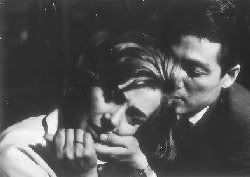How not to fall in love with this film?
From its spellbinding story that solely focuses on the subject of romance itself, we are taken to the world of Hiroshima in 1950s, fresh from its still-open wound due to the unapologetic bombing.
Such a captivating backdrop would deem unthinkable by any conventional norms of making a regular love story, and in fact, it only suits for the making of documentary on world-peace.
This is when Alain Resnais does his playful duty at its best.
Transforming a work of art that was initially conceived as a documentary and turning it into a fictional narrative drama would be a no easy feat. The gritty look of real life is hard to justify to match the aloof look of drama, yet, as magic as the film itself, the two are juxtaposed nicely so as to give the romance theme a stronger, more harsh look, yet it is still based on the lovelorn story of unrequited relationship.
Subtle and demanding our full attention, the film follows the story of a French actress who embarks on a brief affair with a Japanese architect during filming of her latest film in Hiroshima. Both are happily married with their own spouses, yet as the time draws near for the woman's flight to return to her native land, the lovebirds have to face that one question clouding over their heads: who's to stay and who's to leave?
After the anonymosity of name and time, never before such a simple, one word answer, would be so captivating.

Why do we love this film?
Because "... you have such an abundance desire to love".

2 comments:
sugoi ne :-)
Dod,
ganbatte-ne! *lebih ga nyambung* :)
Post a Comment